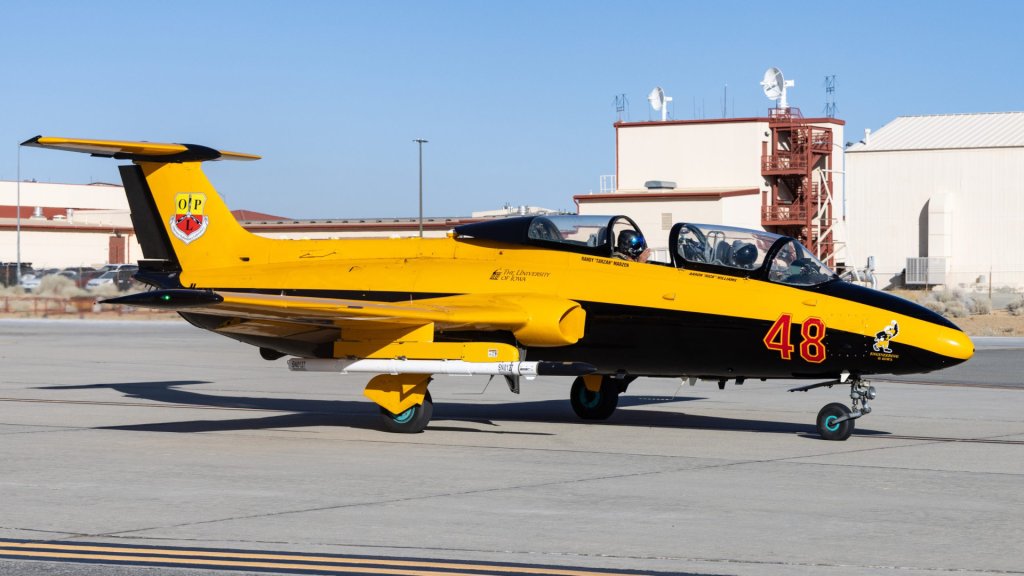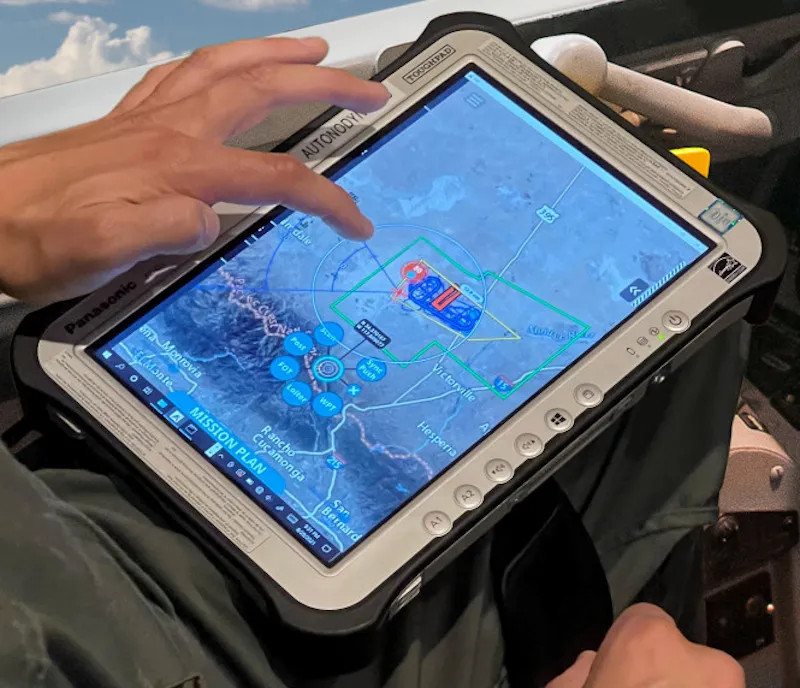A human controller flying in an L-39 Albatros jet ordered a pair of L-29 Delfin jets with artificial intelligence (AI) driven flight technology acting as surrogates for advanced drones to engage simulated enemy fighters in a series of recent flight tests. Lockheed Martin’s famed Skunk Works advanced projects division led the experiment, which reflects growing discussions about how exactly crewed platforms will manage their uncrewed companions in the future. This is becoming a particularly important question for the U.S. Air Force in regard to its Collaborative Combat Aircraft (CCA) program.
Skunk Works collaborated with Lockheed Martin’s own Demonstrations and Prototypes organization and the University of Iowa’s Operator Performance Laboratory (OPL) on the crewed-uncrewed teaming test, according to a company press release. The testing occurred, at least in part, over an unspecified range in Iowa.
“In a series of flight tests, the Skunk Works and OPL teams simulated an offensive counter air mission where an airborne, human ‘battle manager’ aboard an L-39 Albatros assigned targets to two AI-controlled L-29 Delfin jets, which then worked together to defeat two mock enemy jets using simulated mission systems and weapons,” the release stated. “[The] airborne battle manager issued real-time commands to AI-controlled aircraft through a touchscreen pilot vehicle interface (PVI).”

“These flight tests build on previous experiments that demonstrated AI-controlled air-to-ground jamming and geolocation,” the release added. “This year, the tests shifted to AI in air-to-air combat, where AI sends commands directly to the planes’ autopilots. This is the third test of this type and the first to include a real-time human battle manager overseeing the AI’s actions.”
As The War Zone has highlighted in the past, there are significant benefits to using piloted or pilot-optional platforms as surrogates for drones in tests within the United States. The Federal Aviation Administration (FAA) currently imposes significant restrictions on truly uncrewed flight operations inside U.S. airspace. This, in turn, means that pilot-optional aircraft presents significant benefits, especially research and development and test and evaluation activities. Having a human pilot onboard can help accelerate certain kinds of testing and also provides an extra margin of safety.
The U.S. military and other companies beyond Lockheed Martin, such as Shield AI, have used OPLs L-29s, as well as contractor-operated L-39s and other pilot-optional platforms, to support advanced autonomy and drone development efforts in the past for exactly these reasons. In addition, despite continual advances in what can be done in virtual environments through advanced modeling and simulation, being able to conduct live testing remains very important, in general.
“Live flight tests are a crucial aspect of advancing our expertise in AI and autonomy,” Matthew “Gabe” Beard, Lockheed Martin Skunk Works autonomy/AI and machine learning engineering manager, said after another test involving OPL’s L-29s that demonstrated their ability to conduct AI-enabled air-to-air intercepts back in June. “These flights are powerful demonstrations of our ability to quickly and affordably develop and test operationally relevant AI capabilities.”

Lockheed Martin is among an array of U.S. defense contractors working to develop more and more advanced AI agents and expand the envelope of what AI-driven autonomous flight systems can do. This includes General Atomics and Anduril, which also currently developing drones as part of the first phase of the CCA program, also known as Increment 1. Lockheed Martin was among the companies not selected to proceed in Increment 1, but are looking toward the next phase, or Increment 2.
Increasing trust in those systems to do what they are instructed to do by human operators is also a key aspect of this autonomy work. Additional developments are undoubtedly ongoing in the classified realm, as well.
This is hardly the first time Lockheed Martin has demonstrated an operational relevant autonomous flight capability, either. Back in 2015, the company, working together with the CalSpan Corporation, demonstrated the ability of a highly modified pilot-optional F-16 testbed, now designated the X-62A, to fly in formation with a standard two-seat F-16D, break off to fly a preplanned route, and then form back up with the other jet, all while in a semi-autonomous mode. The F-16 testbed took part in a very similar experiment in 2017 that also included the jet carrying out a simulated strike mission.
Since then, the X-62A has been involved in even more advanced autonomy testing work, including a first-of-its-kind AI-driven dogfight with another F-16 just earlier this year. You can read more about that particular jet here.

All of this is being done with a particular eye on meeting emerging U.S. military requirements, especially the autonomy demands that the U.S. Air Force’s CCA program is generating. The Air Force is also working on autonomous capabilities and other technologies to support future drone developments in direct cooperation with the U.S. Navy and branches of the U.S. military through the CCA effort.
“The work we’re doing with the University of Iowa’s OPL is foundational for the future of air combat, where a family of crewed and uncrewed systems will work together to execute complex missions,” John Clark, head of Skunk Works, said in a statement after the recent test. “We’re excited to leverage our diverse skillsets to advance all elements of this new way of operating.”
For the CCA program, there continues to be questions not just about what kinds of missions the highly autonomous drones will expect to perform, but also about how they will be controlled, especially by operators in other aircraft. The touchscreen devices like the one featured in the recent Skunk Works test continue to be a user interface of choice.
“There’s a lot of opinions amongst the Air Force about the right way to go [about controlling drones from other aircraft],” Clark told The War Zone and others at this year’s Air & Space Forces Association’s (AFA) Air, Space & Cyber Conference back in September. “The universal thought, though, is that this [a tablet or other touch-based interface] may be the fastest way to begin experimentation. It may not be the end state.”
The video below from Collins Aerospace presents one notional vision for how advanced drones might operate together with crewed aircraft, including receiving instructions from human operators via touchscreen devices, at least initially.

At the same time, there is growing evidence that tablet-like devices, especially, may create additional burdens for pilots.
“We started with [the Air Force’s] Air Combat Command with tablets… There was this idea that they wanted to have this discreet control,” Michael Atwood, Vice President of Advanced Programs for General Atomics, said during an appearance on The Merge podcast earlier this year. “I got to fly in one of these jets with a tablet. And it was really hard to fly the airplane, let alone the weapon system of my primary airplane, and spatially and temporally think about this other thing.”
“We’re working through a spectrum of options that are the minimum invasive opportunities, as well as something that’s more organically equipped, where there’s not even a tablet,” Skunk Works’ Clark added at the AFA gathering.

The Air Force’s CCA program is increasingly facing a raft of other questions, including about how and where they will operate from, especially on a day-to-day basis domestically within the United States, what it will take to deploy them to forward locations for non-combat and combat missions, and other new training, maintenance, and logistics demands. Serious concerns are also building about the service’s ability to pay for its planned CCA fleets and other modernization plans. You can read more about all of these issues here.
The Navy and other branches of the U.S. military will have to answer the same kinds of questions when it comes to their future drone plans and how those pilotless platforms will be managed.
The latest Skunk Works test involving the “battle manager” riding in the L-39 jet directing the two L-29 aircraft is another step forward in finding the necessary answers to help turn various uncrewed aviation ambitions into realities.
Contact the author: joe@twz.com
